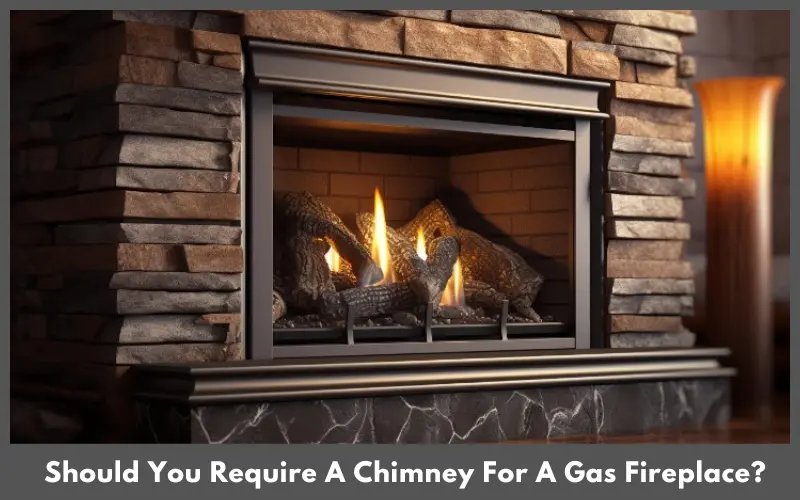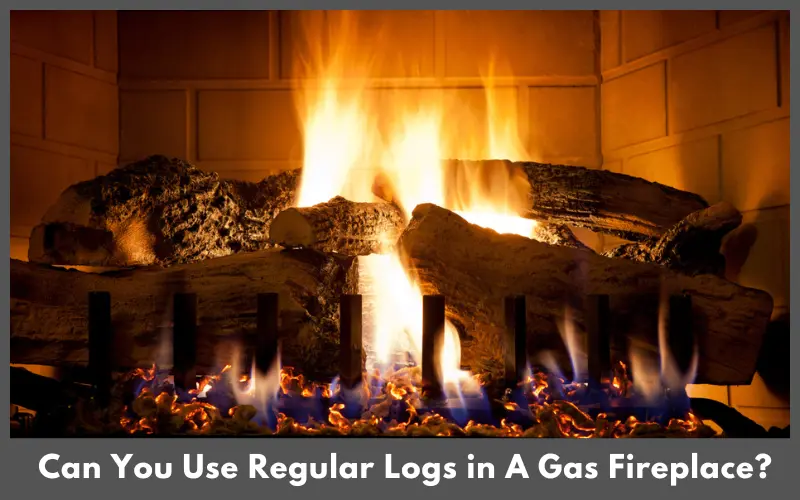A chimney is a vital fireplace component that helps remove carbon dioxide and other byproduct gasses from the air. However, it requires additional maintenance and is very expensive to build. So is chimney mandatory? Does a gas fireplace need a chimney? A gas fireplace usually doesn’t require a chimney.
However, if you have vented gas long or your local building code asks the chimney for a fireplace, you’ll need to install it. Otherwise, you can use direct or natural ventilation for a gas fireplace.
Table of Contents
Should You Require A Chimney For A Gas Fireplace?
A gas log fireplace typically doesn’t require a chimney as this type of fireplace doesn’t produce any combustion byproducts that are required to be vented. Gas log fireplaces use propane or natural gas as a fuel source and burn efficiently and cleanly. So you don’t need to install a flue or chimney for a gas fireplace to vent exhaust from the fireplace.

But you may still need to install a chimney for a gas fireplace particularly if the local building codes and manufacturer recommends it. So you may need to install a carbon monoxide detector and make sure that the fireplace is venting properly to the outside home. You should also inspect the gas fireplace by an expert professional to make sure the fireplace is working efficiently and safely.
Chimney Requirement For Gas Fireplace Based On Type
Below are two types of gas fireplaces that are mostly used in homes along with the requirement of chimney:
1. Vented Gas Logs
Vented gas logs require a chimney as this type of fireplace comes with a much higher BTU rating. Its burner isn’t as efficient as vent-free logs. Vented burners also make carbon monoxide and don’t have many safety features like vent-free units. However, vented burners come with a more realistic look and allow you to stack logs in plenty of ways.
You’ll also require a chimney vent for an open prefabricated gas fireplace. You can install this unit into the existing masonry fireplace using a sleeve installed in the flue.
2. Vent Free Burners
You can install vent-free burners without chimneys particularly if these are listed for use with vent-free logs. These fireplaces come with oxygen depletion sensors that turn off the burners automatically in risky conditions. However free burners are designed with a certain set of logs that need to be used with a specific burner and placed on the burner following the manufacturer’s instructions.
If you want to install a gas fireplace safely, contact a local CSIA-certified chimney sweep or installer who has NFI certifications.
What Can You Use in A Gas Fireplace instead Of The Chimney?
Gas fireplaces don’t require regular cleaning and maintenance as they don’t need chimneys. However, it still requires a ventilation system to vent pollutants, byproducts, or smoke from homes. In this case, you have the following options:
Direct Ventilation
Direct ventilation can remove odors, smoke, harmful byproducts, and polluted air through the roof or wall’s horizontal opening. This type of ventilation also comes with a pane of glass on the outside of fireplaces to allow homeowners to notice fire burning, making it the most popular ventilation system for gas fireplaces.
Natural Ventilation
Natural ventilation systems use brick-and-mortar or pipe structures like a chimney to vent odors, smoke, and contaminated air out of the roof. If you are looking for a stylistic alternative to a chimney for a gas fireplace, natural ventilation can be your right option.
Power Vents
An electric vent or power vent uses a fan to vent air out of the home. Homeowners rarely use this type of ventilation system for gas fireplaces.
Vent-Free
If you don’t want to install a chimney with a gas fireplace, use a vent free fireplace. It’s also a decent alternative to traditional fireplaces particularly for its appearance. However, vent-free gas fireplace allows the fireplace’s heat to stay in the room along with air pollutants and odors. So free gas fireplaces can cause breathing problems particularly those who are sensitive to air quality.
Can You Use Regular Logs in A Gas Fireplace?
No, you can’t use regular logs in a gas fireplace. This type of fireplace is UL-listed and suitable for burning natural gas. The gas appliance needed to use with the gas fireplace is a B vent double wall. Gas fireplace is also designed for a maximum operating temperature of 400 degrees F, however, it can be operated at around 500 to 600 degrees F.

An older gas fireplace was designed with a draft hood to turn cool room air into a stack while reducing temperature. These types of fireplaces could endure up to 2000 degrees F temperature. But you can’t compare modern gas fireplaces with older ones. So you shouldn’t put wood into a gas fireplace. Even if you can burn down your home insurance due to improperly putting wood in the gas fireplace.
Is A Ventless Gas Fireplace Safe?
There are a lot of controversies and misconceptions about the safety of a ventless gas fireplace. So comparing the pros and cons of ventless gas fireplaces can help you make the right decision for your health and comfort.
Pros of Ventless Gas Fireplace
- A ventless gas fireplace is cheaper to install than a vented fireplace. This is because it doesn’t require any remodeling to run the flu.
- It doesn’t produce ash and soot like a wood-burning fireplace.
- You can place a ventless fireplace in any room of the house, making it suitable to use supplementary heat at desired place.
- Ventless gas fireplaces make very little flames compared to vented fireplace
- The ventless gas fireplace is more energy efficient compared to a vented one. This is because it doesn’t allow heat to escape up the flue to save energy bills. In comparison, a vented gas fireplace burns more gas to produce the same warmth as it lets heat escape through the flue.
Cons of ventless gas fireplace
- Though ventless gas fireplaces produce very few fumes, fumes remain in the house.
- A ventless gas fireplace is not allowed in some areas. So you must make sure your local building codes allow you to build a ventless gas fireplace in your area.
- Gas combustion of this fireplace creates a little bit of water vapor that can feel muggy or humid.
FAQs on Does A Gas Fireplace Need A Chimney
How Long Can You Run A Gas Fireplace With A Chimney?
You can operate a fully vented gas fireplace with a sealed glass front continuously for a long time. But if you have a vent-free gas fireplace and it is front door operable, you can’t run it for more than three hours at a time.
How Tall Does A Gas Fireplace Chimney Need To Be?
If you want to build a class of chimney pipes for a gas fireplace, you can follow 3-2-10 foot rules. It means the chimney pipes above the roof should be a minimum of three feet and it should be two feet taller than anything within ten feet.
Can You Have An indoor Fireplace Without A Chimney?
Yes, you can install an indoor fireplace without a chimney. In this case, you have to choose a ventless gas fireplace.
Final Words
So, gas fireplaces don’t need a chimney in most cases. However, if it doesn’t hurt your house exterior, you should install a chimney in terms of your health concerns and fume appearance.
If you still want to install a gas fireplace without a chimney, make sure your local building code allows you to do so. Finally, take the aid of a certified professional to ensure the proper installation of the gas fireplace and enjoy safe and efficient operation.

